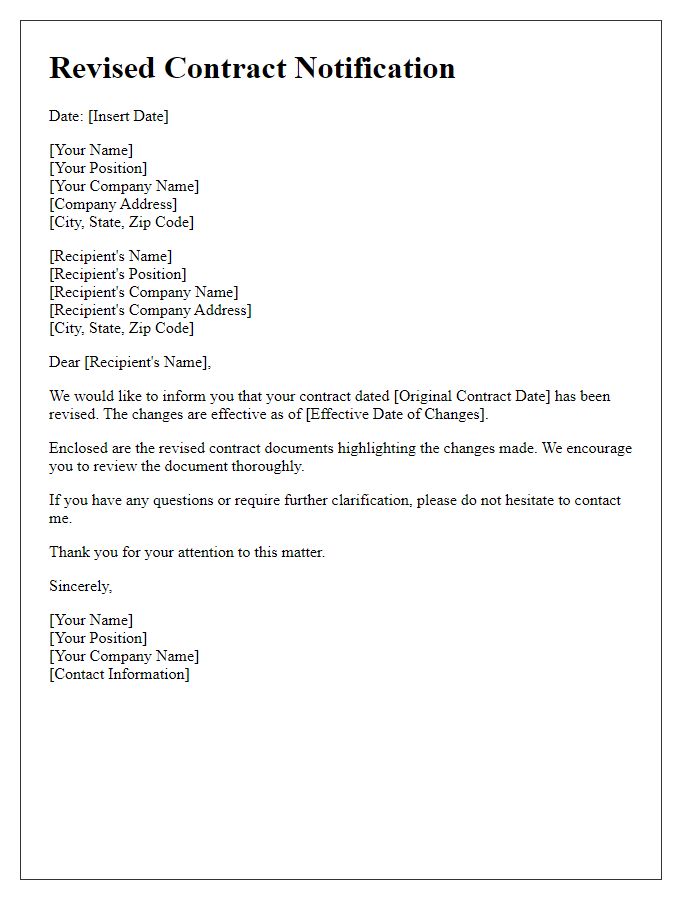Hey there! If you're navigating the sometimes tricky waters of contract amendments, you're not alone. Updating a contract can seem daunting, but with the right approach and wording, it can smooth the way for both parties. In this article, we'll delve into a handy letter template that can help you confirm those important changesâso stick around to learn more!

Contract Title and Parties Involved
The contract amendment process is crucial in formalizing changes within an existing legal agreement, such as a Service Agreement or Partnership Contract. When addressing parties involved, clarity is essential; for instance, the original signatories, like ABC Corporation and XYZ Enterprises, must be explicitly listed to avoid ambiguity. Moreover, references to the original contract date (e.g., January 15, 2020) and the specific amendments detailed (such as an increase in service fees or an extension of the contract term by six months) will ensure both parties understand their obligations. Highlighting the effective date of the amendment is vital, as it determines the commencement of the changes. Legal language should clearly define provisions, such as 'modifications,' to avoid misunderstandings in future interactions.
Amendment Details and Changes
Contract amendments serve to formalize adjustments made to existing agreements, ensuring all parties are informed and in agreement. Key elements often include the specific amendment number, date of issuance (such as October 18, 2023), and details regarding the original contract (like Contract ID #12345). Changes might involve modifications to payment terms, service delivery schedules, or scope of work. It's crucial to outline the proposed revisions clearly to eliminate confusion, referencing original clauses that are being altered. Additionally, signatures from authorized representatives of involved parties solidify the agreement's enforceability and signify acknowledgment of revised terms.
Statement of Agreement and Acknowledgment
The contract amendment confirmation serves as an official document that outlines the agreement and acknowledgment between the parties involved, ensuring mutual understanding of the modifications to the original contract. This document typically includes vital details such as the amendment date, specific sections of the contract being altered, and the reasons for the changes, which may pertain to financial agreements, deadlines, or performance requirements. Additionally, both parties' signatures signify acceptance of the modifications and compliance with applicable laws or regulations governing contracts in their jurisdiction, such as the Uniform Commercial Code in the United States. Proper documentation of these amendments is crucial for maintaining legal protections and clarity in business relationships.
Effective Date of Amendment
The effective date of the amendment to the contract will be specified, typically aligning with the signing date of the confirmation or an agreed-upon date between the parties involved. This amendment, which modifies specific clauses within the original contract, serves to provide clarity and accommodate any changes in circumstances or terms agreed upon in the negotiations. For instance, if the initial contract was signed on January 1, 2023, and the amendment is agreed upon on March 15, 2023, the effective date may be retroactively set to January 1, 2023, or on the amendment signing date, depending on the mutual agreement. Proper documentation and communication regarding the effective date ensure that all parties understand when the amended terms begin to apply, preventing disputes and misunderstandings.
Signatures and Contact Information
A contract amendment confirmation should document all necessary signatures and contact details clearly. Essential elements include the names of parties involved, their respective roles (such as "Client" and "Service Provider"), and the date of the confirmation document. Each party's physical address, email address, and phone number should be included for clarity and ease of communication. Specific signatures must be collected to validate the amendment, along with printed names and the date signed. It's essential to ensure that both parties retain a copy of this document for future reference and verification purposes, preserving transparency and legal integrity throughout the amendment process.













Comments